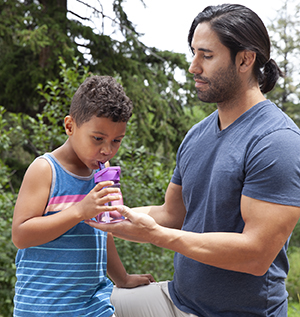Prevent Heat-Related Illness in Your Child
Heat-related illness occurs when the body’s temperature gets too high. Body temperature can be affected by the temperature and humidity of the air and by level of physical activity. To protect your child from heat-related illness, follow the tips on this sheet.
What are the symptoms of heat-related illness?
Heat-related illness can range in symptoms from mild (heat cramps), to moderate (heat exhaustion), to severe (heat stroke).
-
Mild: heat cramps
-
Sweating a lot
-
Painful spasms in muscles during activity or hours later (heat cramps)
-
Tiny red bumps on skin and a prickly sensation (heat rash or prickly heat)
-
Feeling irritable, dizzy, or weak
-
Moderate: heat exhaustion
-
Sweating a lot
-
Cold, moist, pale, or flushed skin
-
Feeling very weak or tired
-
Headache, nausea, vomiting, or loss of appetite
-
Rapid or weak pulse
-
Painful muscle cramps
-
Severe: heat stroke
If your child has symptoms of heat stroke, call 911 or take your child to the emergency department right away.
-
Little sweating; or may be sweating a lot
-
Hot, dry skin that looks red, gray, or bluish
-
Deep, fast breathing
-
Headache or nausea
-
Rapid, weak, or irregular pulse
-
Feeling dizzy, confused, or delirious
-
Fainting
-
Convulsions or other shaking movements
-
Irritability, confusion, or altered mental status
-
Rapidly rising temperature to over 104°F (40°C)
How is heat-related illness treated?
If your child has symptoms of heat exhaustion or heat stroke, call 911 or take your child to the nearest emergency room. You can also start treatment yourself by doing the following:
-
Remove your child from the heat, direct sun, or warm air that is causing the illness; move to an air-conditioned area, if possible.
-
Give your child chilled fluids, such as water, to drink to prevent dehydration. Babies can be given a children’s electrolyte solution. If your child won't drink fluids, is vomiting, or appears confused and has more serious signs of heat-related illness, they may need IV fluids.
-
Apply cool compresses on your child’s forehead, neck, and underarms.
-
Use a fan to blow cool air onto your child’s skin.
-
Give your child a bath in cool water to bring down body temperature. Make sure the water is not so cold as to cause shivering.
How is heat-related illness prevented?

You can do the following to prevent your child from getting heat-related illness:
-
Give your child plenty of fluids to drink.
-
Dress your child in clothing appropriate for the weather. Light-colored clothes don't absorb as much heat.
-
Have your child rest and take breaks during exercise or physical activity.
-
Never leave your child in a car, even if the windows are open. Cars can get dangerously hot very quickly.
On hot days, also do the following:
-
Keep your child indoors or in shaded or cool areas.
-
Give your child more fluids than usual.
-
Spray cool water on your child to keep them cool.
-
Dress your child in fewer layers and loose-fitting clothing. Have your child wear a hat or a visor.
-
Do strenuous activities early in the morning or later in the evening. Avoid peak sunlight hours of the day.
© 2000-2025 The StayWell Company, LLC. All rights reserved. This information is not intended as a substitute for professional medical care. Always follow your healthcare professional's instructions.